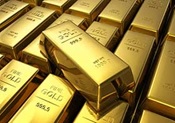Poor Economic And Corporate Outlook Will Lift Gold Prices Much Higher This Year

 Has Janet Yellen turned into a Gold Bug? The Fed policy statement this week was certainly good for gold with prices jumping from $1,225 to $1,263 an ounce on the news that the central bank does not intend to have as many interest rate hikes as previously stated.
Has Janet Yellen turned into a Gold Bug? The Fed policy statement this week was certainly good for gold with prices jumping from $1,225 to $1,263 an ounce on the news that the central bank does not intend to have as many interest rate hikes as previously stated.
When asked whether that meant the Fed had run out of policy options she was kind enough to remind her audience that no, QE was still an alternative if necessary.
QE or not QE?
Play that kind of monetary music and gold prices go higher. This is not just a matter of sentiment and interest rate expectations now either.
The CPI inflation figure of 2.3 per cent for February puts the US way into negative real interest rate territory, that is to say, what you earn from holding money does not compensate for what you lose to inflation.
Hold gold and rising inflation usually result in a sharp rise in the dollar value of your investment.
Goldman Sachs restated its wholly erroneous view on the gold price again on the day of the Fed statement. It continues to argue that rising US interest rates this year will crush the gold price that pays no interest by comparison.
Goldman Sucks
Will the Wall Street titan now reverse direction having seemingly lost the support of the Fed which is dialing back interest rate expectations as fast as it can go? The European giant ABN Amro did just that a couple of months ago and today says it’s current $1,300 an ounce forecast for the year-end may be too conservative.
For what is the outlook for the global economy and corporate profits this year? Clearly we only have to demonstrate a weakening environment, and not necessarily a financial crisis or stock market crash, to support the notion of rising gold prices.
The immediate reason for Fed caution this week is not hard to grasp. Falling US retail sales since the New Year are a bad sign for an economy that is 70 percent consumer driven. The money saved on gas prices is not being spent in McDonald’s.
At the same time, there is barely a bright light shining in the global economy outside the borders of the United States.
Asian Implosion
The economic reports from Asia are particularly bad. The Chinese economic colossus continues to slow down with witheringly bad trade data. The Japanese economy is almost as big and in even worse shape. It could be the first market to really crack in something like a repeat of the Asian Financial Crisis of the late 90s.
Negative interest rates adopted by the Bank of Japan a few months back have proven a disaster, strengthening the yen rather than weakening it as expected while risking a destabilizing feedback loop.
Meanwhile, Chinese devaluation hangs like the Sword of Damocles over the global financial system. Last summer this triggered a wave of collapses in global stock markets and it would do again. Yet how else is China to make its goods competitive again and trade its way out of the current slump?
In Europe the governor of the European Central Bank, Mario Draghi shot himself in the foot with a statement that his negative interest rate regime would not be going any lower and had reached its limit. Again negative interest rates seem to be having the reverse of the intended effect and strengthening rather than weakening the currency concerned.
Stock Market Bust
And all this while most major stock markets are at or close to peak valuations! It’s an accident just waiting to happen.
At the corporate level profits will come under pressure from the deteriorating global picture. Commodity producing countries, for example, are already mainly in recession or close to it and cannot afford to keep buying as much as they used to.
Then there are the bankruptcies and the banking crisis to come from the implosion of the oil and gas sector over the past year. The oil price also rallied with the gold price this week but it is too little, too late for the heavily indebted shale oil industry.
If history is any guide then the commodity complex as a whole is now due for a rebound as some supply is cut and speculative money available at ultra-low interest rates exaggerates the upswing. What’s that going to do to US CPI inflation data and inflationary expectations?
Gold Prices
It’s all good news for the price of gold, which has already had its best start to the year since 1974. Is that telling us something about underlying conditions for a return of inflation?
Most readers will not remember 1974 or the 1973-4 financial crisis when oil prices quadrupled. US inflation was running at 25 percent in 1975 after the Dow Jones first lost 45 per cent in a huge bear market. Gold prices more than doubled.
Could it be that the universal money printing by global central banks since the Global Financial Crisis finally results in a massive inflation?
Well nobody expected it in 1975 either, and certainly not my father who was almost bankrupted as a property developer at that time. The price of building materials doubled during the construction phase of his last project before he took a long break.
Danger Signals
It is in the nature of such crises that you don’t see them coming though always in retrospect you can recall the danger signals: rampant money printing, a stock market and other asset prices far too high, wildly fluctuating commodity prices and geopolitical instability.
In these circumstances gold prices should be far higher than they are today, and that is the whole point, they soon will be and only have one way to go in 2016. A fast deteriorating global economy in which the Fed is forced to abandon rate hikes is not good for business and low-interest rates have created a house of cards in asset prices.
As this house of cards falls the gold price will continue on up and up!

















